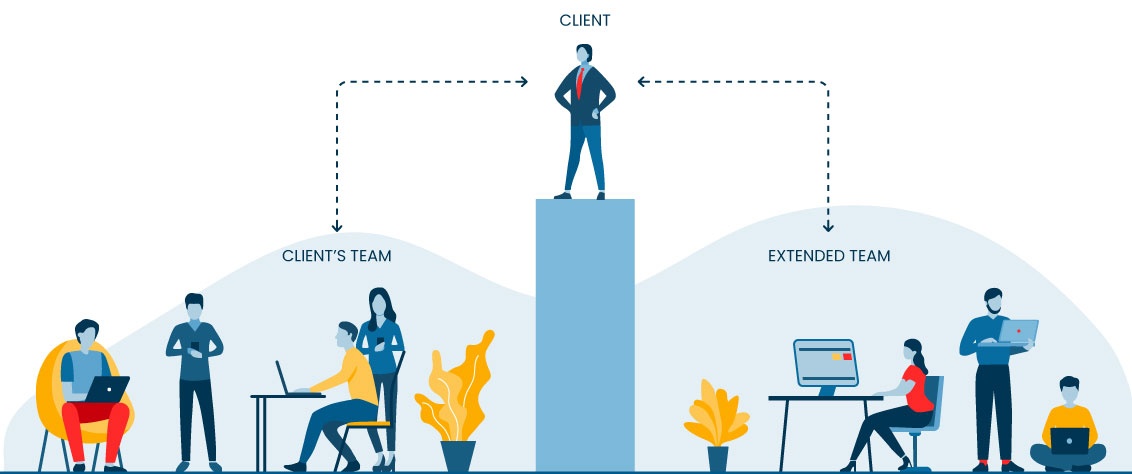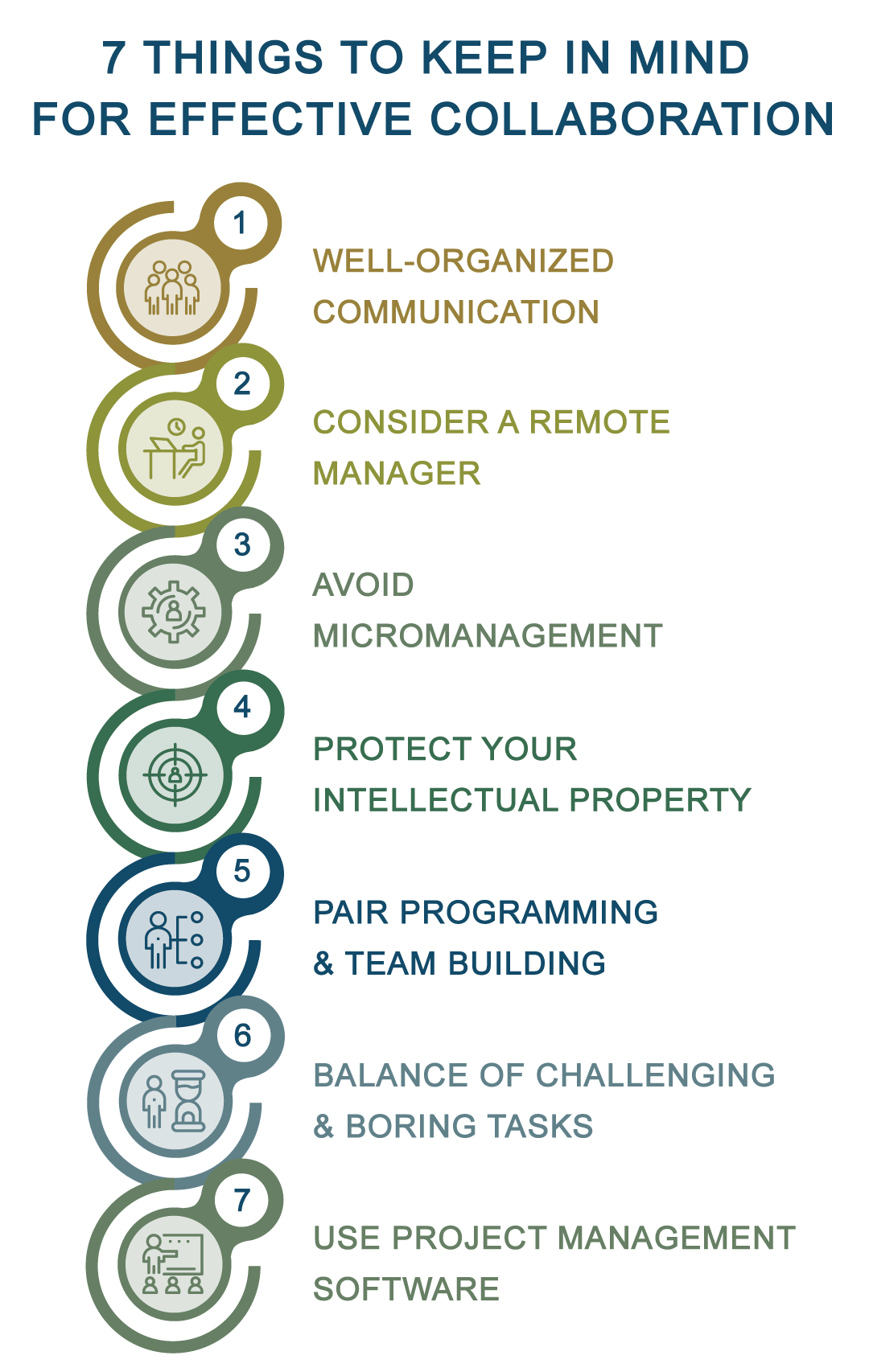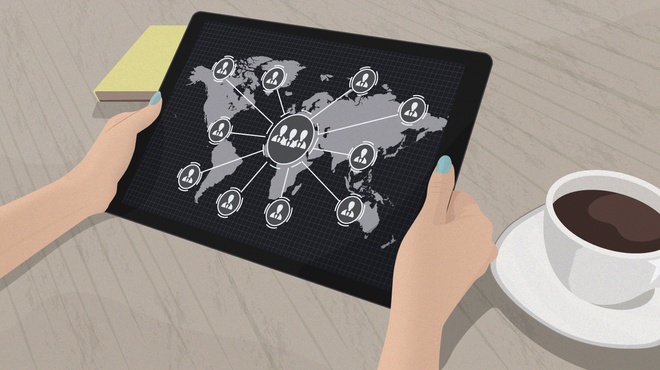Checklist on How to Effectively Work with a Hired Developer (Team)

Outstaffing is gaining more and more popularity these days. Undoubtedly, this is a useful strategy with lots of potential. But once you hire a developer or team, you might face challenges with organizing work properly. We gathered the most relevant tips for you in a single checklist.
Outstaffing: What’s That?
Outstaffing is the practice of hiring a remote team to work on your projects. It must be noted, outstaffing is not outsourcing.
Outsourcing is when you delegate a task to an external party, whereas outstaffing involves collaborating with a dedicated remote team that is solely focused on your project.

Outstaffing Model
Benefits of Outstaffing
- Access to a larger talent pool and specialized skills.
- Cost-effectiveness.
- Increased efficiency.
- Flexibility and less administrative work.
- Global markets reach.
All in all, outstaffing offers skilled professionals, cost savings, and improved efficiency by hiring flexible remote teams. It also enhances global market reach and job satisfaction, making it a go-to strategy for businesses.
If you’re searching for tips on hiring developers or selecting the right team, take a look here.
7 Things to Keep in Mind for Effective Collaboration
Let’s cut to the chase and move on to some practical tips. Here are seven key points for you to consider after hiring a team or developer

1. Well-Organized Communication
Though this may seem a little obvious, we can’t help but mention it.
This one tiny moment addresses multiple problems: cultural fit, adaptation, motivation and psychological tension of the remote team, which may end up interfering with your project efficiency.
Take actions:
Set clear project needs and expectations
Elaborate your point on every moment regarding the quality of work, deadlines, and deliverables. Make sure the team understands your requirements and sticks to them along the way. If there are any major changes concerning the project, all team members must be aware of them.
Provide feedback and ask for it
Two-way communication is vital. Feedback will help your hired developers improve their performance and ensure that the project meets your expectations.
At the same time, encouraging your employees to speak out will prevent a lot of problems from happening. Finding a common language should be a priority.
Progress reviews
Track your teams’ progress and don’t skimp on bonuses if they pull out the stops for the project.
Practice agile methodology
Companies that successfully implemented agile transformations saw an increase in productivity, operational performance, and employee engagement of 30%, according to a McKinsey Global Survey. We have a detailed description of this method on our blog.
2. Сonsider a Remote Manager
According to a study, performed by Harvard Business Review, delegating more can increase your earnings. It suggests delegating tasks you don’t have to do yourself. So that you can spend more time on doing the most significant things.
Thus, consider assigning someone to be in charge of overseeing reporting operations, or turn to your outstaffing provider with this suggestion.
A remote manager can assist you in streamlining communication, resolving difficulties, and guaranteeing effective collaboration between the external and internal teams. They will also provide you and the team with all the details about your project and act as a middleman in some important matters.
Additionally, a remote manager can help ensure that the project stays on track and meets its deadlines. They can also have valuable insights and recommendations based on their experience working with other teams. You can focus on your core business activities while still ensuring that your outsourced team is working effectively.
3. Avoid Micromanagement
However, having everything managed is a double-edged sword. It’s a great idea to work hard on organizing management processes, but not too hard. That’s all about the golden mean.
There is research on how autonomy keeps businesses competitive. It implies that managers who wish to yield economic results should not only allow autonomy to employees but also give them a support system to use such autonomy.
Besides, having a remote team from other countries will bring your company a brand new vision and different approaches. So, encouraging them to be creative will do good for both their own skill growth and your company’s success.
4. Protect Your Intellectual Property
Teamwork is built on trust but it should be documented. Businesses using cutting-edge technologies and sensitive data may be hesitant to outstaff. When you onboard a remote workforce that is owned by another company, there are worries regarding data leaks and intellectual property security.
Make sure you have a contract that includes a confidentiality clause to protect your intellectual property. Take precautions like enforcing NDAs, limiting emails and other communications.
5. Pair Programming & Team Building
Practicing pair programming for introductory projects will be beneficial for your remote team’s adaptability to the project. At the same time, you will encourage cooperation and smooth communication between your in-house and outstaffed team.
Forbes found out that companies that promote collaborative working are 5 times more likely to perform at a high level. Organizing team building activities and seminars for your staff should improve their performance. This is because collaboration is at the core of team building.
What’s more, regular check-ins and open communication channels can also help foster a sense of teamwork and collaboration.
6. Balance of Challenging & Boring Tasks
This tip is relevant for both of your teams. Combine important, challenging tasks with less exciting but necessary ones. This will keep your team engaged and motivated, and discover their strong suits.
This balance can help prevent burnout and maintain productivity levels. Additionally, consider rotating tasks among team members to provide variety and prevent being stuck in a rut.
7. Use Project Management Software
Last but not least – utilize project management tools. There are many of them available to track progress, assign tasks, and communicate with the developers, including Trello, Asana, and Jira. Modern technology and well-organized systems will make your job much simpler and more effective.
According to Mckinsey up to 80% of businesses use social collaboration tools to boost business productivity. They can help you stay on top of deadlines and ensure that all team members are on the same page. It can also provide valuable insights into project performance and help identify areas for improvement.
Conclusion
An international study performed by Deloitte found that workplace collaboration saves companies thousands of dollars per employee. Therefore, effective communication along with a reliable vendor saves both time and money, while helping your business thrive.
At Aristek, we can provide you with a team of professionals and assist you in organizing these processes.
We’ve also joined DesignRush to offer our services there. Hire our team using any convenient for you way!



